
Home - Search - Browse - Alphabetic Index: 0- 1- 2- 3- 4- 5- 6- 7- 8- 9
A- B- C- D- E- F- G- H- I- J- K- L- M- N- O- P- Q- R- S- T- U- V- W- X- Y- Z
MiG 105-11
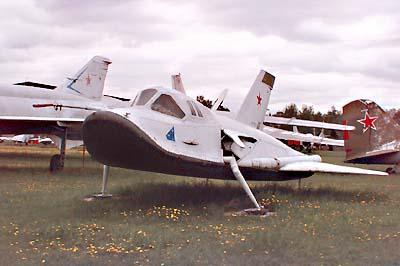
MIG 105 at Monino
The MIG-105 EPOS (Experimental Passenger Orbital Aircraft displayed at the Monino Air Museum outside of Moscow.
Credit: A Zhelyeznakov
AKA: Spiral EPOS. Status: Operational 1976. Thrust: 14.70 kN (3,305 lbf). Gross mass: 4,220 kg (9,300 lb). Unfuelled mass: 3,720 kg (8,200 lb). Height: 8.50 m (27.80 ft). Diameter: 2.80 m (9.10 ft). Span: 6.40 m (20.90 ft).
The MiG OKB had studied a two stage manned orbital spacecraft in collaboration with the Korolev (overall system integration) and Tupolev (Mach 6 airbreathing first stage) since 1965. Go-ahead to actually proceed with development of the manned orbital vehicle was given on 26 June 1966 and Lozino-Lozinsky was selected as project manager. However the ambitious project never had the leadership support or funding to meet its aggressive schedule. A cosmonaut training group was formed, but went through many changes before being dissolved. After the decision to proceed with the Buran space shuttle, all that was left of Spiral was a subsonic aerodynamic test vehicle, now designated EPOS (Experimental Passenger Orbital Aircraft) and flown by Air Force test pilots. On 11 October 1976 this made its first flight, taking off from an old dirt airstrip near Moscow, flying straight ahead to an altitude of 560 m, and landing at the Zhukovskiy flight test center 19 km away. One year later, on November 27, the first air-drop launch from a Tu-95K (used previously for Kh-20 air to surface missile tests) was made from an altitude of 5,000 m, with landing on skids on a beaten earth air strip. The eighth and final flight was made in September 1978, resulting in a hard landing and the write-off of the aircraft. First and last flights were made by test pilot A. G. Festovets. The eight flights were considered sufficient to characterize the spaceplane's subsonic aerodynamic characteristics and airbreathing systems. Although the MiG 105-11 was designed by the bureau to be adapted directly into a manned orbital spaceplane for launch from a Vostok or Soyuz booster, the decision was taken to use the configuration but develop a larger manned orbital vehicle for launch from the Zenit booster or by other means (see Uragan and Bizan).
The 105-11 incorporated the airframe and some of the systems of the planned orbital version. The spaceplane itself was a flat-bottomed lifting body with a large upturned nose that earned it the nickname 'Lapot' (wooden shoe). The nose design was found to greatly reduce afterbody heating during reentry and was adopted by NASA in its HL-20 proposal of the 1980's. The load-bearing structure, like that of the US X-20, consisted of a network of struts and longerons. The outer skin was articulated to permit thermal expansion during reentry. A unique feature of the spaceplane were the variable dihedral wings. These were set at a 60 degree angle above horizontal during launch, orbit, and reentry, where they served as vertical stabilizers. After becoming subsonic, dual electric actuators moved them to a horizontal position, where they served as wings, substantially increasing the lift of the spaceplane for airbreathing operations. The main body of the spaceplane had a sweepback angle of 78 degrees, and the wings, 55 degrees. The large vertical stabilizer had a sweepback of 60 degrees. Aerodynamic controls consisted of the vertical rudder, elevons in the wings, and air brakes mounted at the top rear of the fuselage. Landing gear normally consisted of four skids, in a tail-dragging configuration, the long frontal skids deploying in a complex manner from landing gear bays mounted on the sides of the spaceplane above the heat shield.
The airbreathing propulsion consisted of a Koliesov RD-36-35K turbojet of 2,350 kgf with 500 kg of fuel, which amounted to 10 minutes of cruise at full thrust. This was used, with wheels attached to the forward skids, for takeoffs from unpaved airstrips. In the orbital version, it would give the spaceplane a chance to 'go around' or divert to a secondary airfield in the event of bad weather or a missed approach (the US Shuttle was originally to have such engines, but they were dropped for weight reasons). The 176 kg engine was fed from a dorsal intake at the base of the vertical stabilizer. This intake was covered during launch and orbital operations; an actuator opened the housing once the spaceplane reached subsonic speed.
Orbital propulsion consisted of a 1,500 kgf primary engine, with two 40 kgf backup engines. Orbital attitude control and translation were provided by two reaction control system (GDU) pods at the rear of the spaceplane flanking the backup engines. There were a total of six 16 kgf engines for coarse adjustment and ten 1 kgf engines for fine maneuvers. Fuel tanks for these system were located in the center of the spaceplane.
The cosmonaut-pilot sat in an insulated escape capsule, which could be ejected free of the spaceplane in an emergency. Normally the pilot had to climb into the spaceplane through a hatch above the seat. Controls consisted of a conventional control column and rudder pedals, with separate controllers for the jet engine and the rocket engines. An automatic navigation and control system (SNAU) operated the aerodynamic or reaction controls according to the fight regime. Manual backup was available for the aerodynamic controls.
Crew Size: 1. RCS Coarse No x Thrust: 6 x 157 N. RCS Fine No x Thrust: 10 x 10 N.
Family: Spaceplane, Suborbital. Country: Russia. Launch Vehicles: Spiral 50-50. Agency: MiG. Bibliography: 197, 376, 474, 81, 83.
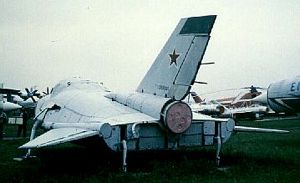 | Mig-105 back view Credit: Stefan Wotzlaw |
 | Spiral 50-50 Credit: © Mark Wade |
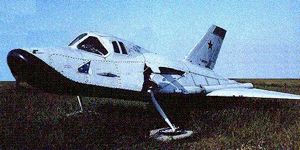 | Spiral 2 The MIG-105 EPOS (Experimental Passenger Orbital Aircraft displayed at the Monino Air Museum outside of Moscow. |
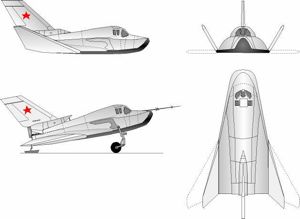 | Spiral 3 view Spiral 3 view drawing Credit: © Mark Wade |
 | Spiral MiG-105-15 Spiral MiG-105-15 drawing Credit: © Mark Wade |
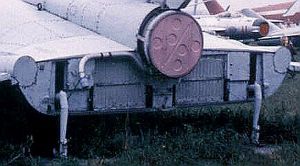 | Mig-105 back view Mig-105 back view close-up Credit: Stefan Wotzlaw |
1964 June 18 - .
- USSR five-year military space plan issued. - .
Nation: Russia.
Related Persons: Chelomei,
Malinovskiy.
Spacecraft: MiG 105-11,
Raketoplan,
Soyuz R,
Spiral OS,
US-A,
US-P,
Zenit-2M satellite,
Zenit-4M.
Ministry of Defence Decree 'On military space programs for 1964-69, including the R spaceplane' was issued. The decree was issued by Defence Ministry Marshal Rodiono Yakovlevich Malinovksiy. Included in this plan were new versions of the automatic Zenit, Morya-1 (US series) spacecraft, the Spiral spaceplane, the Soyuz-R manned combat spacecraft, and others. Chelomei's Raketoplan spaceplane was cancelled.
1965 January 1 - . Launch Vehicle: Spiral 50-50.
- Spiral development at MiG bureau authorised. - . Nation: Russia. Spacecraft Bus: Spiral 50-50. Spacecraft: MiG 105-11. Decree 'On plan of work on Spiral at OKB-155' was issued..
1965 June 1 - .
- Beginning of Project Spiral - .
Nation: Russia.
Related Persons: Chelomei,
Korolev.
Class: Manned.
Type: Manned spaceplane. Spacecraft Bus: Spiral 50-50.
Spacecraft: MiG 105-11.
With the cancellation of Chelomei's desultory R spaceplane development, the job is handed to 'the profis' - the fighter design bureaus of MiG and Sukhoi. Both would use an air breathing first stage (the XB-70 clone T-4 in Sukhoi's case, a huge new Tupolev hypersonic aircraft 'to be developed' in MiG's case). Second stage would be a conventional expendable rocket stage which would carry the relatively small Spiral spaceplane into orbit. Korolev had been doing some 'back door' work with MiG in competition to Chelomei's R project for some time (Began with 1962 Mikoyan study '50-50': Hypersonic first stage to Mach 5.5; rocket stage with one man), and immediately proposed tests from atop R-7 rockets as early as 1967. At the time all this was begun Dyna Soar was still an active US program.
1966 June 26 - . Launch Vehicle: Spiral 50-50.
- Development of Spiral spaceplane authorised - . Nation: Russia. Spacecraft: MiG 105-11, Spiral OS. Lozino-Lozinsky was selected as project manager. The Spiral system consisted of three main components: the GSR reusable hypersonic air-breathing launch aircraft; RB expendable two stage rocket; and the OS orbital spaceplane..
1967 June - .
- Original planned date for first Spiral subsonic tests - . Nation: Russia. Class: Manned. Type: Manned spaceplane. Spacecraft Bus: Spiral 50-50. Spacecraft: MiG 105-11. This would actually not occur until ten years later..
1969 June 30 - .
- Spiral project cancelled - . Nation: Russia. Class: Manned. Type: Manned spaceplane. Spacecraft Bus: Spiral 50-50. Spacecraft: MiG 105-11. No competing US project any more, huge obstacles in getting Tu-144 SST to fly at Mach 2 sustained let alone Mach 4 sustained for Tupolev's Spiral first stage..
1970 June 30 - .
- Original plan for tests of Spiral - . Nation: Russia. Class: Manned. Type: Manned spaceplane. Spacecraft Bus: Spiral 50-50. Spacecraft: MiG 105-11. Original planned date for first flight tests of Spiral with rocket first stage..
1974 June 30 - .
- Spiral project resurrected - . Nation: Russia. Related Persons: Glushko. Class: Manned. Type: Manned spaceplane. Spacecraft Bus: Spiral 50-50. Spacecraft: MiG 105-11. Glushko supports modest project to do subsonic flight tests of Spiral orbiter configuration..
1976 October 11 - . Launch Vehicle: Spiral 50-50.
- MiG 105-11 first flight - . Nation: Russia. Spacecraft Bus: Spiral 50-50. Spacecraft: MiG 105-11. The EPOS spaceplane made its first flight, taking off from an old dirt airstrip near Moscow, flying straight ahead to an altitude of 560 m, and landing at the Zhukovskii flight test center 19 km away. Pilot was A. G. Festovets..
1977 June 30 - .
- Originally planned full up Spiral flight - . Nation: Russia. Class: Manned. Type: Manned spaceplane. Spacecraft Bus: Spiral 50-50. Spacecraft: MiG 105-11. Original planned date for flight test of Spiral with airbreathing hypersonic first stage..
1977 November 27 - . Launch Vehicle: Spiral 50-50.
- MiG 105-11 first air-drop - . Nation: Russia. Spacecraft Bus: Spiral 50-50. Spacecraft: MiG 105-11. The first air-drop launch from a Tu-95K (used previously for Kh-20 air to surface missile tests) was made from an altitude of 5,000 m, with landing on skids on a beaten earth air strip..
1978 September - . Launch Vehicle: Spiral 50-50.
- MiG 105-11 final flight - .
Nation: Russia.
Spacecraft Bus: Spiral 50-50.
Spacecraft: MiG 105-11.
The eighth and final flight resulted in a hard landing and the write-off of the aircraft. First and last flights were made by test pilot A. G. Festovets. The eight flights were considered sufficient to characterize the spaceplane's subsonic aerodynamic characteristics and air breathing systems.
Back to top of page
Home - Search - Browse - Alphabetic Index: 0- 1- 2- 3- 4- 5- 6- 7- 8- 9
A- B- C- D- E- F- G- H- I- J- K- L- M- N- O- P- Q- R- S- T- U- V- W- X- Y- Z
© 1997-2019 Mark Wade - Contact
© / Conditions for Use